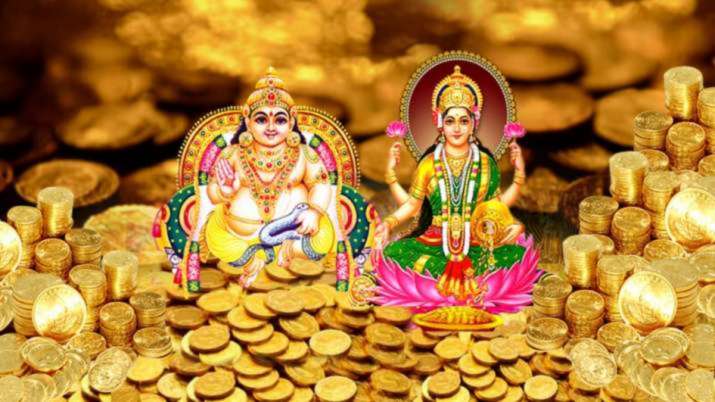Fesitvals
Navaratri: The Nine Divine Nights of Maa Durga!
Published
5 years agoon
By
Vedic Tribe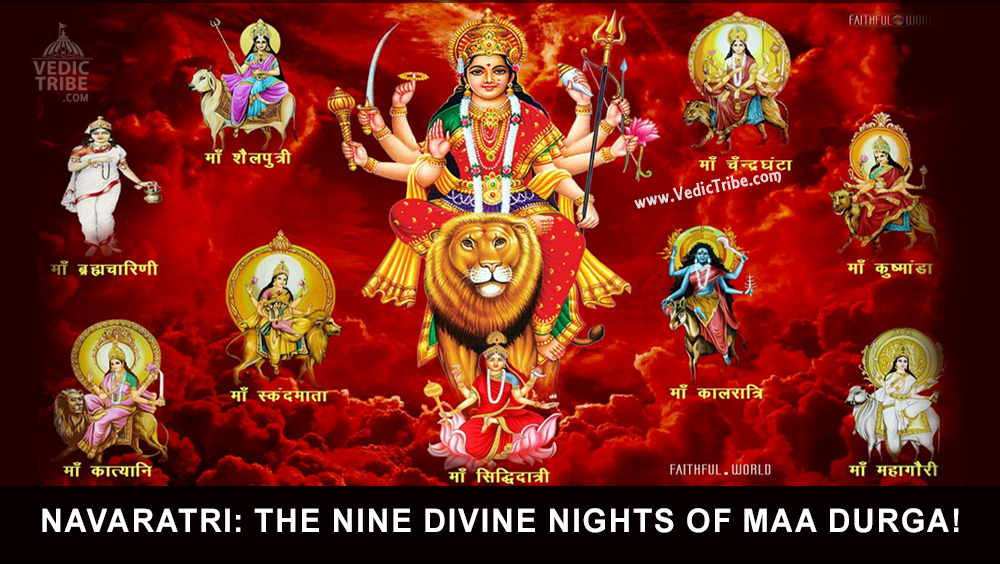
– Shri Gyan Rajhans
Navratri or the nine holy days are auspicious days of the lunar calendar according to Hinduism. Celebrated with fervor and festivity all over north India, and every Hindu community the world over, these nine days are dedicated solely to Maa Durga (Goddess Durga) and her nine avatars.
During Navratri, Maa Durga is worshipped in nine forms. All forms have their own significance and they all are merciful to us.
- Day 1: Pratipada To mark the commencement of Navaratri, a ritual called Ghatasthapana is performed to invoke the energy of the goddess. On Pratipada, the goddess is worshiped as Shailputri, an incarnation of Goddess Parvati meaning “Daughter of the Mountain”. She represents nature and purity. The color to be worn on this day is yellow.
- Day 2: Dwitiya is when the goddess is worshiped as Brahmacharini, the unmarried form of Goddess Parvati. As she undertook great penance to get Lord Shiva to marry her, she’s associated with pious strictness. The color to be worn on this day is green.
- Day 3: Tritiya is when the goddess is worshiped as Chandraghanta, the married form the Goddess Parvati. Her name is derived from the half moon on her forehead, which looks like a bell. She’s depicted riding on a tigress, and is associated with bravery and courage to fight evil. The color to be worn on this day is gray.
- Day 5: Panchami is when the goddess is worshiped as Skandamata, the mother of Kartikeya (also known as Skanda), son of Lord Shiva and brother of Lord Ganesha. The color to be worn on this day is white.
- Day 6: Shasthi is when the goddess is worshiped as Katyayani, who Goddess Parvarti morphed into in order to fight and destroy the buffalo demon Mahishasura. She represents a warrior form of the goddess. The color to be worn on this day is red.
- Day 7: Saptami is when the goddess is worshiped as Kalaratri, the dark night. She appeared to destroy some particularly evil demons in the battle against Mahishasura. She’s the goddess’s fiercest form and represents protection from all troubles. The color to be worn on this day is royal blue.
- Day 8: Ashtami is when the goddess is worshiped as Mahagauri, the younger version of Shailputri who had a very fair and perfect complexion. She represents beauty and grace, and the cleansing of sins. The color to be worn on this day is pink.
- Day 9: Navami is when the goddess is worshiped as Siddhidatri, who embodies all eight siddhis (supernatural powers). She is believed to have granted them to Lord Shiva when he worshiped her, and she also bestows them upon her devotees. The color to be worn on this day is purple.
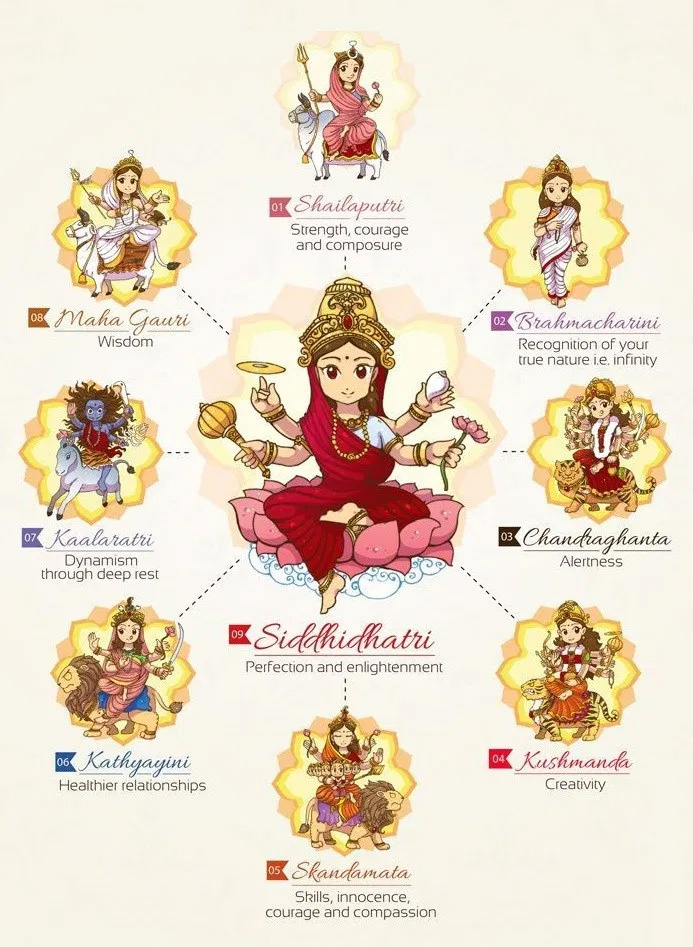
Note that in south India, Goddess Durga is worshiped during the first three days of the Navaratri festival, followed by Goddess Lakshmi during the next three days, and finally Goddess Saraswati on the last three days.
All nine days during Navratri are dedicated to nine forms of Goddess Shakti. Most customs and rituals followed during Shardiya Navratri, which falls in the month of September or October, are also followed during Chaitra Navratri. Ghatasthapana Puja Vidhi for Shardiya Navratri and Chaitra Navratri is same.
Chaitra Navratri is more popular in northern India. In Maharashtra Chaitra Navratri begins with Gudi Padwa and in Andhra Pradesh it begins with Ugadi.
What’s the Significance of Navratri?
During Navaratri, we invoke the energy aspect of God in the form of the universal mother, commonly referred to as “Durga,” which literally means the remover of miseries of life. She is also referred to as “Devi” (goddess) or “Shakti” (energy or power). It is this energy, which helps God to proceed with the work of creation, preservation and destruction. In other words, you can say that God is motionless, absolutely changeless, and the Divine Mother Durga, does everything. Truly speaking, our worship of Shakti re-confirms the scientific theory that energy is imperishable. It cannot be created or destroyed. It is always there.
Why Worship the Mother Goddess?
We think this energy is only a form of the Divine Mother, who is the mother of all, and all of us are her children. “Why mother; why not father?”, you may ask. Let me just say that we believe that God’s glory, his cosmic energy, his greatness and supremacy can best be depicted as the motherhood aspect of God. Just as a child finds all these qualities in his or her mother, similarly, all of us look upon God as mother. In fact, Hinduism is the only religion in the world, which gives so much importance to the mother aspect of God because we believe that mother is the creative aspect of the absolute.
Why Twice a Year?
Every year the beginning of summer and the beginning of winter are two very important junctures of climatic change and solar influence. These two junctions have been chosen as the sacred opportunities for the worship of the divine power because:
- We believe that it is the divine power that provides energy for the earth to move around the sun, causing the changes in the outer nature and that this divine power must be thanked for maintaining the correct balance of the universe.
- Due to the changes in the nature, the bodies and minds of people undergo a considerable change, and hence, we worship the divine power to bestow upon all of us enough potent powers to maintain our physical and mental balance.
Why Nine Nights & Days?
Navaratri is divided into sets of three days to adore different aspects of the supreme goddess. On the first three days, the Mother is invoked as powerful force called Durga in order to destroy all our impurities, vices and defects. The next three days, the Mother is adored as a giver of spiritual wealth, Lakshmi, who is considered to have the power of bestowing on her devotees the inexhaustible wealth. The final set of three days is spent in worshipping the mother as the goddess of wisdom, Saraswati. In order have all-round success in life, we need the blessings of all three aspects of the divine mother; hence, the worship for nine nights.
Why Do You Need the Power?
Thus, I suggest you join your parents in worshipping “Ma Durga” during the Navaratri. She will bestow on you wealth, auspiciousness, prosperity, knowledge, and other potent powers to cross every hurdle of life. Remember, everyone in this world worships power, i.e., Durga, because there is no one who does not love and long for power in some form or the other.
You may like
-


Seven Vows and Steps (pheras) of Hindu Wedding explained
-


Atithi Devo Bhava meaning in Hinduism and India
-


Significance of Baisakhi / Vaisakhi
-


Significance of Bilva Leaf – Why is it dear to Lord shiva?
-


Concept of Time and Creation (‘Brahma Srishti’) in Padma Purana
-
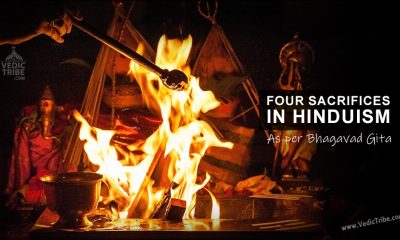

Four Sacrifices in Hinduism according to Bhagavad Gita
Fesitvals
Significance of Baisakhi / Vaisakhi
Published
5 years agoon
April 13, 2021By
Vedic Tribe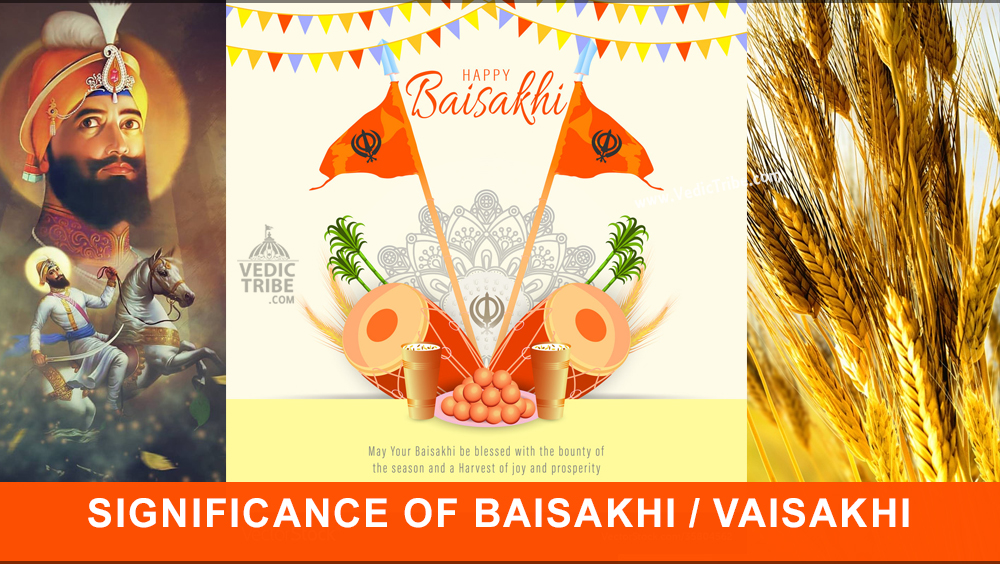
Baiskhi is also spelled ‘Vaisakhi’, and is a vibrant Festival considered to be an extremely important festival in India. It is celebrated all over India under different names and rituals.
Astrological Significance of Baisakhi
The festival of Baisakhi falls on April 13 every year and April 14 once in every 36 years. Change in date is because of the fact that date of Baisakhi is reckoned according to the solar calendar. Astrologically, the date of Baisakhi is significant as marks sun’s entry into Mesh Rashi.
For this very reason, many people also know Baisakhi as Mesha Sankranti. The auspicious date of Baisakhi is celebrated all over India under different names and rituals. It is celebrated as ‘Rongali Bihu’ in Assam, ‘Naba Barsha’ in Bengal, ‘Puthandu’ in Tamil Nadu, ‘Pooram Vishu’ in Kerala and ‘Vaishakha’ in the state of Bihar.
Significance of Baisakhi for Farmers
For the agriculturally rich state of Punjab and Haryana, Baisakhi marks the time for harvest of Rabi (winter) crops and is therefore extremely significant for the farmers. Baisakhi Festival is also celebrated as a Thanksgiving Day festival in these states. After waking up early and dressing themselves in new clothes, farmers visit temples and gurdwaras to express gratitude to God for the good harvest and seek blessing for ensuing agriculture season. Farmers also celebrate Baisakhi by performing energetic bhangra and gidda dance and participating in Baisakhi Fairs.
Significance of Baisakhi in Sikhism
Baisakhi is of major importance for the people following Sikh faith. As it was on a Baisakhi Day, in the year 1699 that the Tenth Guru of Sikhs, Guru Gobind Singh founded Khalsa Panth or the Order of Pure Ones and gave a unique identity to Sikhs. On the same day the guru administered amrit (nectar) to his first batch of five disciples making them Singhs, a martial community. By doing so, he eliminated the differences of high and low and established that all human beings were equal.
Baisakhi is New Year’s Day in Punjab. It falls on the month of Vaisakh. This festival marks the ripening of the Rabi harvest. The day coincides with the solar equinox on the13th of April. It was on this day that the tenth Sikh Guru, Guru Gobind Singh, founded the Khalsa (the Sikh brotherhood) in 1699. For Sikhs, this is as a collective birthday. It is celebrated on April 13, though once in 36 years it occurs on 14th April.
Sikhs celebrate Baisakhi by participating in special prayer meetings organized at gurdwaras. They also carry out joyful Baisakhi processions to mark the day.
Significance of Baisakhi in Other Religions
The day of Baisakhi is of significance for the Hindus as it was on this day in 1875 that Swami Dayanand Saraswati founded the Arya Samaj – a reformed sect of Hindus who are devoted to the Vedas for spiritual guidance and have discarded idol worship. Besides, Baisakhi day is of relevance for the Buddhists as Gautama Buddha attained enlightenment and Nirvana on this auspicious day.
In Kerala, the festival is called ‘Vishu’. It includes fireworks, shopping for new clothes and interesting displays called ‘Vishu Kani’. These are arrangements of flowers, grains, fruits, cloth, gold, and money are viewed early in the morning, to ensure a year of prosperity.
In Assam, the festival is called Bohag Bihu, and the community organizes massive feasts, music and dancing. Bengalis mark it as new years day or ‘Naba Varsha’ or Pohela Boishakh in Bengal, Assam and Tripura.
Puthandu (Tamil New Year) in Tamil Nadu. Whatever the history says, today Baisakhi is celebrated with all pomp and show in almost all parts of the country.
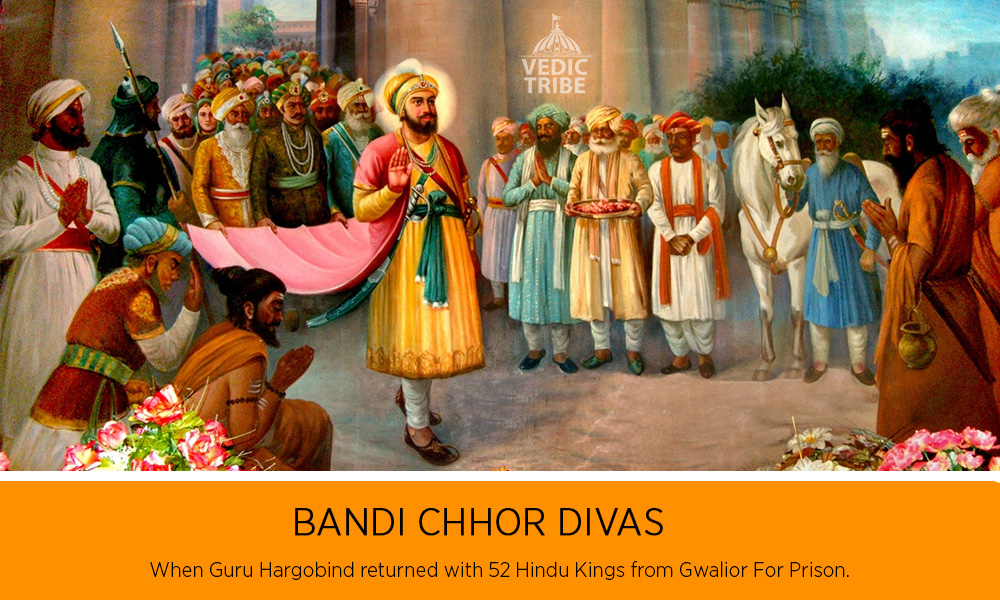
When Guru Hargobind returned with 52 Hindu Kings from Gwalior For Prison.
-By Immy Kaur
I must only accept and appreciate my freedom, with the freedom of all of humanity.
Globally, Diwali is celebrated as the festival of lights. It is arguably one of the biggest celebrations inside and outside of India for the South Asian community. What is most incredible is the diversity of significance of the day for a number of different faith communities including Hindus, Jains and Sikhs.
So often I have come across people who don’t know that the festival as a deep significance for the Sikh community. It’s easy to write a historical account of the Bandi Chorr. Instead I share a personal reflection of what the day means for me. I am not particularly drawn to the significance of physical days and do not necessarily regard one day more holy or auspicious than another. However in the fast-paced world we live in, taking time out to reflect on what I feel is important is often highly driven by festivals, and holiday periods when I take extra time to think about what the history of my ancestors means to me today.
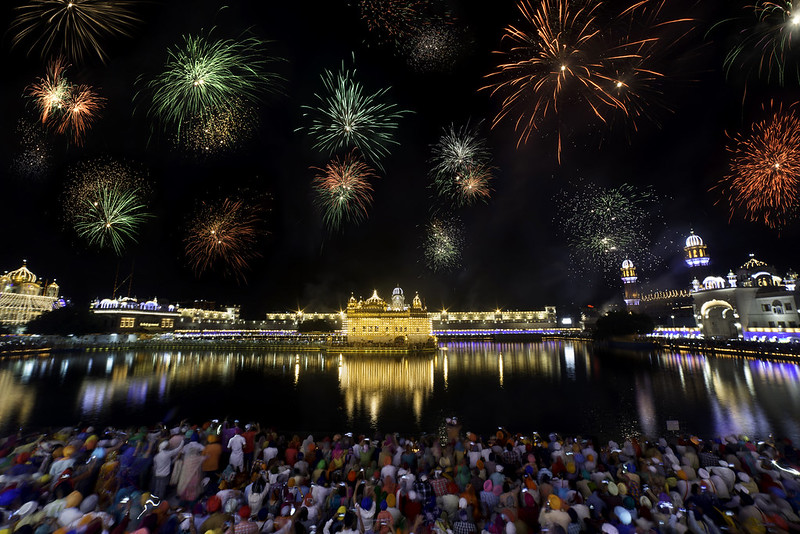
It was on this day that 52 Hindu kings were by the Grace of Sri Guru Hargobind Ji released from the Mughal Emperor Jahangir’s Gwalior Fort (Madhya Pradesh, India). It was for this reason Sikhs celebrate Bandi (prison) Chorr (release) — Guru Sahib Ji was offered freedom but refused unless the other princes, who were today’s equivalent of political prisoners / prisoners of conscience, were released also. Emperor Jahangir cleverly agreed on the condition that only those who could hold on to Guru Sahib’s cloak would be released; Guru Sahib thus had his Sikhs design a cloak with 52 tassels and was released along with all the princes. The lesson for humanity from Guru Sahib is that one should contemplate the suffering of others before one’s own and that the freedom and rights of others is more important than one’s own.
As a Sikh I feel incredibly inspired by the courage and leadership that the sixth Guru of the Sikhs, Guru Hargobind Sahib Jee, showed in 1619. The Sikhs celebrate this event as ‘Bandi Chorr’ at the same time as the Diwali festival. There are a number of messages that come from Guru Sahib’s compassion and determination during his captivity, and when ensuring the release of the 52 Hindu kings with him, despite the chance to be freed alone. For me, Guru Sahib fought with dignity for justice not only for himself but also for the Hindu kings who were in captivity. This is a shining example of bold courage and leadership, and Guru Sahib’s practical application and display of compassion to justice and people of all faiths.
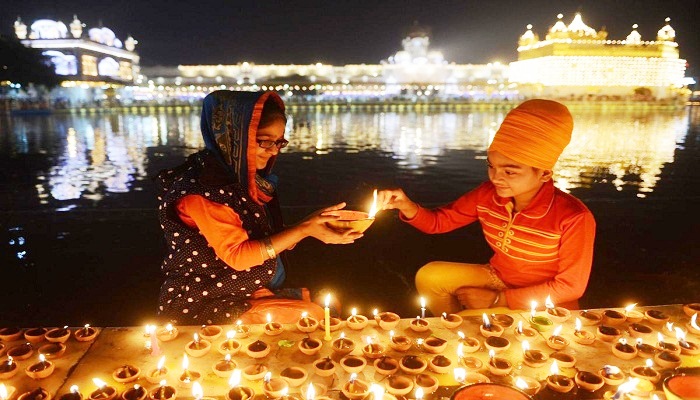
Sikhs have remembered this historic occasion for four centuries. Once again I question myself about how we as a community are acting to capture that essence of freedom, freedom for ourselves, freedom for our neighbors, freedom for all through our core principle of Sarbat da Bhalla, uplifting and ensuring prosperity of all.
My prayer and hope as people of faith is that we can practically apply the teachings of our Gurus to make a real difference, not as charity but as justice. For me today is a time to remember hope — to not be dragged into political battles, or disagreements — but instead to remember there is hope. Today, I must re-energize myself and discover my place within the very difficult and challenging circumstances many people in my community and the wider world find themselves in.
Guru Sahib accepted his freedom only with the freedom of others, what is our understanding of the concept of freedom in this globalized world?
Fesitvals
What is Diwali and why is it celebrated?
Published
5 years agoon
November 14, 2020By
Vedic Tribe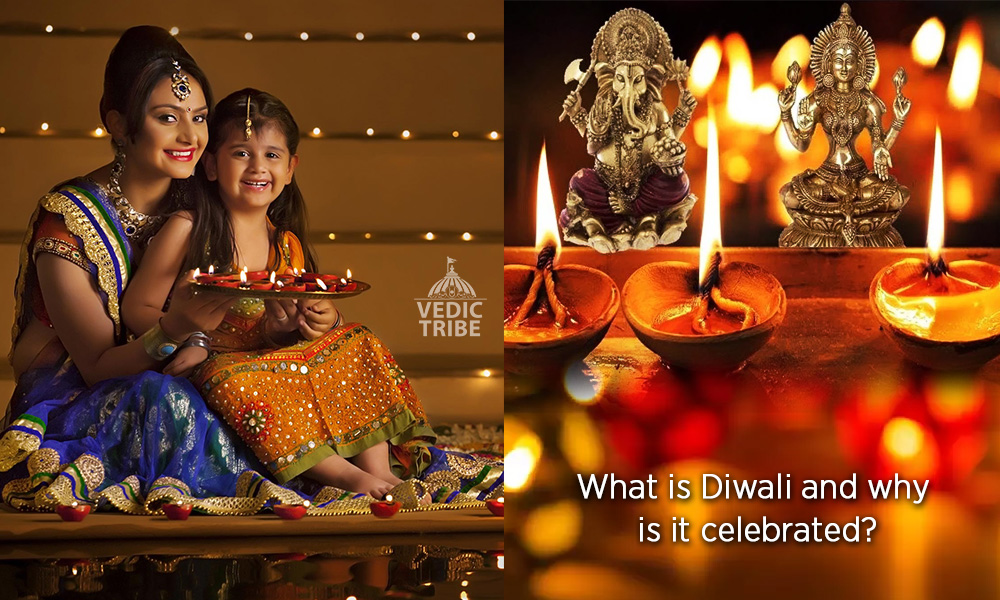
Diwali is celebrated with full enthusiasm as the festival of lights. Fireworks have become a major part of the Diwali celebrations. The ancient celebration is linked to multiple stories and it’s impossible to say which came first, or how long ago Diwali started. Many of these stories are about the triumph of good over evil. In northern India, a common tale associated with Diwali is about King Rama, one of the incarnations of the god Vishnu. King Rama’s return to Ayodhya after he defeated Ravana. People in Ayodhya welcomed Bhagwan Rama and Sita by lighting rows of clay lamps. Southern India celebrates it as the day that Bhagwan Krishna defeated the demon Narakasura freeing 16000 women from evil. In the western state of Gujarat, the New Year coincides with Diwali and associated with asking the goddess Lakshmi for prosperity in the coming year.
Diwali is the five-day festival of lights, celebrated by millions of Hindus, Sikhs and Jains across the world.
Diwali, which for some also coincides with harvest and new year celebrations, is a festival of new beginnings and the triumph of good over evil, and light over darkness.
In India, the five-day celebration marks the biggest holiday of the year.
First Day – Dhanteras
First Day, Dhanteras: Worshipping of Yama and buying a huge amount of gold, silver and precious stones, ornaments, new clothes, and utensils. On this day, Dhanvantari is believed to have come out of the ocean with Ayurveda, the science of medicine, for the benefit of mankind.
Second Day – Narak Chaturdasi
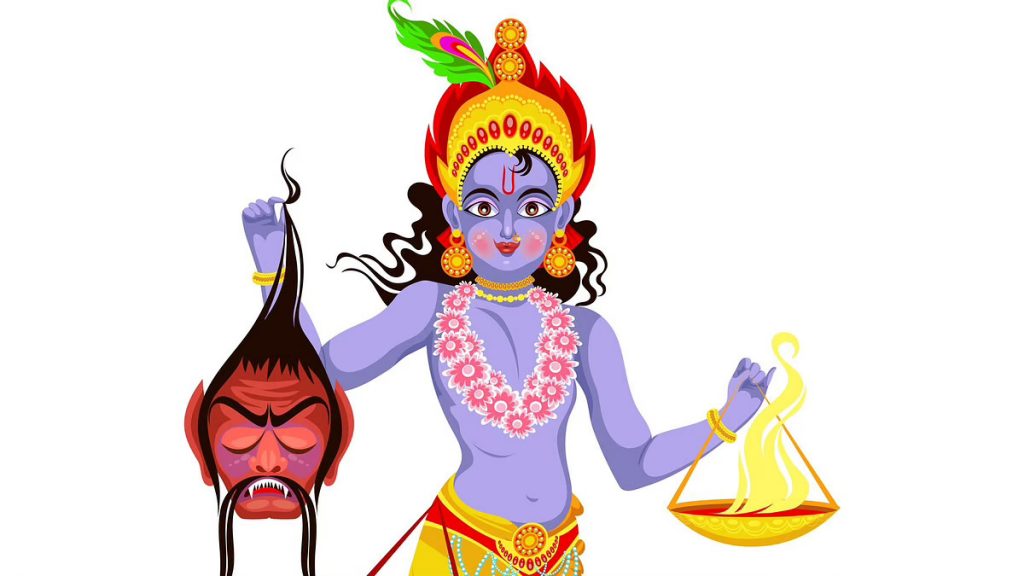
The Second day of Diwali week is called the Kali Chaudas or Narak Chaturdasi, Roop Chaturdashi, Narak Chaturdashi In some parts of India, it is simply the Choti Diwali, On this day Bhagwan Krishna is known to have destroyed the demon Narakasur, freeing the world from fear.
Third Day – Deepavali
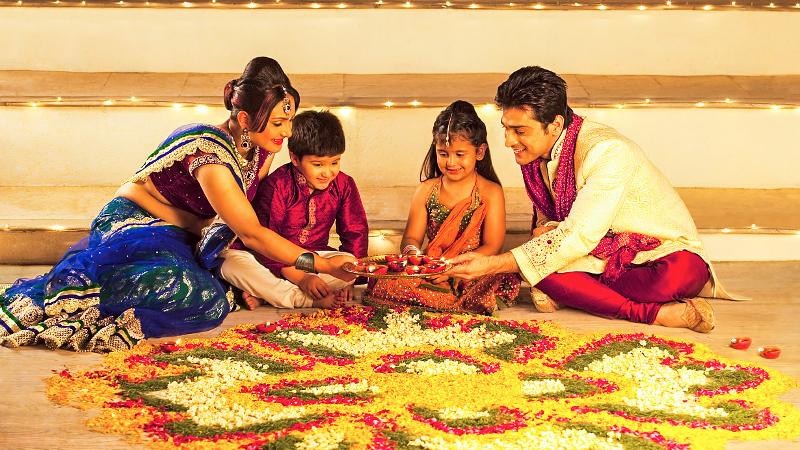
The Third day of these festivities is the actual Diwali/ Deepawali, when Goddess Lakshmi is worshipped, along with Bhagwan Ganesha. People light diyas and candles in their homes, and the streets all across is lit up with millions of lights, diyas, and bursting of crackers
Fourth Day – Govardhan Puja
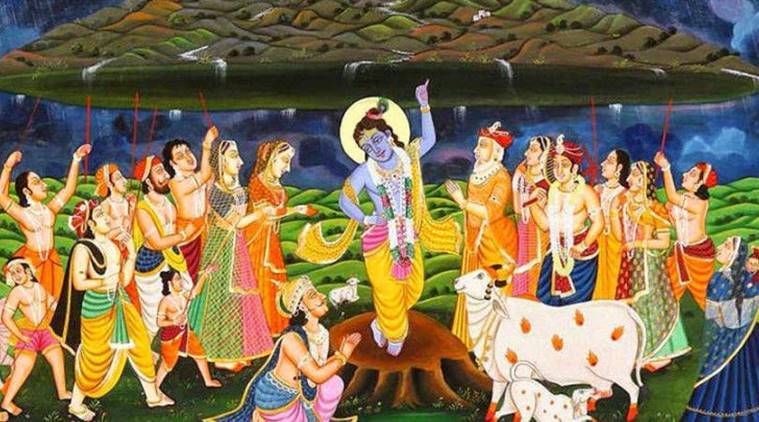
The Fourth Day is celebrated as Govardhan Puja and Bali Pratipada also known as Padava. Govardhan Puja is celebrated as the day Krishna defeated Indra asked the people to worship nature.
Fifth Day – Bhai Dooj
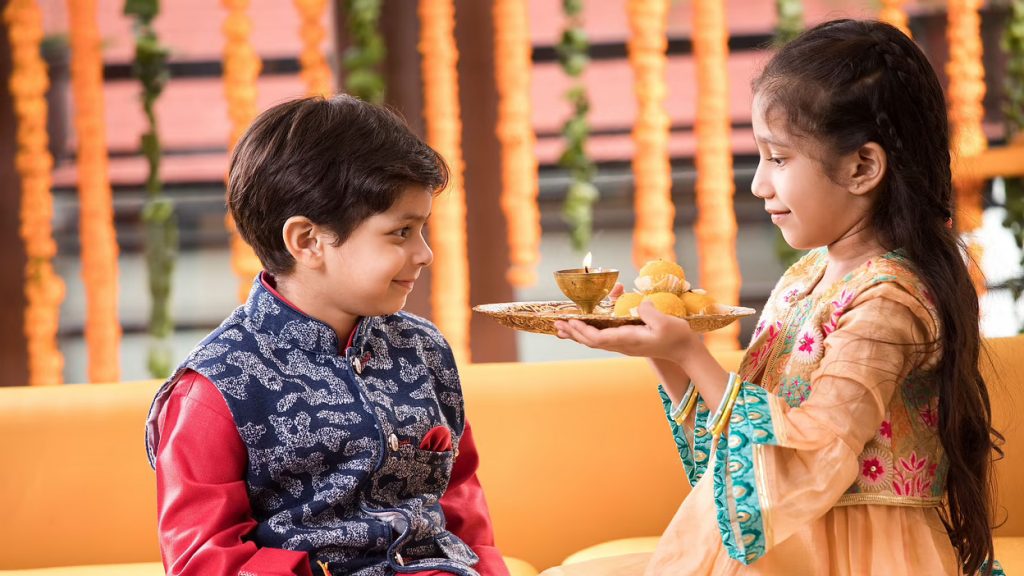
The Fifth day of Diwali festivities is celebrated as the Bhai Dooj or Bhai Beej or Bhai Teeka/ Tilak. It is made up of two words namely- “Bhai” meaning brother and “Dooj” meaning the second day after the new moon which is a day of its celebration. On the day of the festival, sisters invite their brothers for a sumptuous meal often including their favorite dishes/sweets. The procedure may be different in Bihar and central India. The whole ceremony signifies the duty of a brother to protect his sister, as well as a sister’s blessings for her brother.
Reasons to celebrate Diwali:
From the Rama’s return to Ayodhya to Sikh Guru Hargobind’s release from Mughal captivity, here are all the reasons why the festival of lights is so popular through the length and breadth of the country.
While the overarching reason for celebrating Diwali is the victory of good over evil, the festival of lights is in fact celebrated for various reasons around the country. Here are seven reasons why we celebrate Diwali in India.
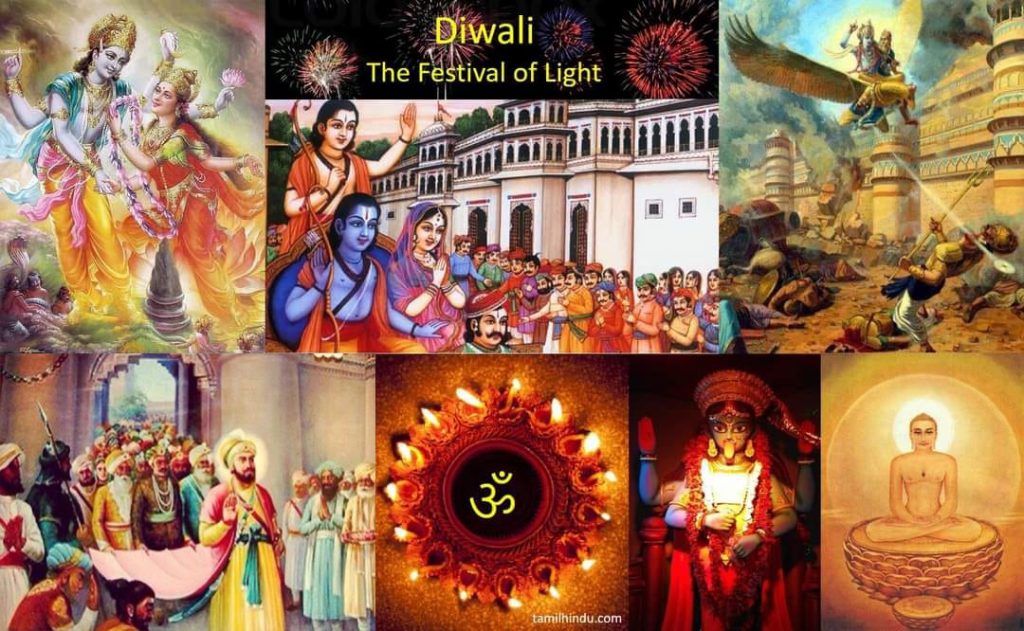
1. Return of Bhagwan Rama to Ayodhya
According to the ‘Ramayana’, it was the new moon day of Kartik when Bhagwan Ram, Sita and Lakshman returned to Ayodhya after vanquishing Ravana and conquering Lanka. The citizens of Ayodhya decorated the entire city with the earthen lamps and illuminated it like never before.
2. Birth of Goddess Lakshmi and her wedding with Bhagwan Vishnu
The Goddess of wealth, Lakshmi incarnated on the new moon day (amaavasyaa) of the Kartik month during the churning of the ocean (samudra-manthan), hence the association of Diwali with Lakshmi and married to Bhagwan Vishnu.
3. Vishnu Rescued Lakshmi:
On this very day (Diwali day), Bhagwan Vishnu in his fifth incarnation as Vaman-avtaara rescued Lakshmi from the prison of King Bali and this is another reason of worshipping Ma Larkshmi on Diwali.
4. Krishna Killed Narakaasur:
On the day preceding Diwali, Bhagwan Krishna killed the demon king Narakaasur and rescued 16,000 women from his captivity. The celebration of this freedom went on for two days including the Diwali day as a victory festival. Narkasura’s downfall is just one more reason why Diwali is celebrated in India. In Goa, large effigies of Narkasura are burnt to commemorate the event.
5. The Return of the Pandavas:
According to the great epic ‘Mahabharata’, it was ‘Kartik Amavashya’ when the Pandavas appeared from their 12 years of banishment as a result of their defeat in the hands of the Kauravas at the game of dice (gambling). The subjects who loved the Pandavas celebrated the day by lighting the earthen lamps.
6. Coronation of Vikramaditya:
One of the greatest Hindu King Vikramaditya was coronated on the Diwali day, hence Diwali became a historical event as well.
7. Special Day for the Arya Samaj:
It was the new moon day of Kartik (Diwali day) when Maharshi Dayananda, one of the greatest reformers of Hinduism and the founder of Arya Samaj attained his nirvana.
8. Special Day for the Jains:
Even though Jains abstain from fireworks because they believe it harms other living beings, the community does celebrate Diwali in its own quiet way to commemorate Mahavira’s attainment of Moksha or eternal bliss. But it wasn’t just Mahavira’s big day; his disciple of Ganadhara Gautam Swami also reached a state of Kevalgyana on the day, making Diwali all the more important to the small but prosperous Jain community.
9. Special Day for the Sikhs:
The third Sikh Guru Amar Das institutionalized Diwali as a Red-Letter Day when all Sikhs would gather to receive the Gurus blessings. In 1577, the foundation stone of the Golden Temple at Amritsar was laid on Diwali. In 1619, the sixth Sikh Guru Hargobind, who was held by the Mughal Emperor Jahengir, was released from the Gwalior fort along with 52 kings.
10. The killing of the demons, Shambhu and Nishambhu
Born from the forehead of Durga, Kali went on to kill Shambhu and Nishambhu, two demons who had terrorized humans and gods alike. After having killed them, Ma Kali went on a rampage destroying everything and everyone that lay in her path till Bhagwan Shiva threw himself before her. Shocked by the sight, Ma Kali stopped in her tracks. Just like Ma Durga, Ma Kali is also worshiped widely in West Bengal.
11. End/beginning of the harvest season
Diwali is as much a festival of farmers as it is a festival of merchants. The kharif harvest season draws to a close around this time of the year and the celebrations traditionally involve a simple ritual of making delicacies out of poha or puffed rice taken from the freshly-harvested crop. In Gujarat too, the time marks the beginning of a new harvest season and traders also close all financial accounts and clear debts for the year to begin afresh.
Follow us on Facebook
Follow us on Twitter
Latest


Seven Vows and Steps (pheras) of Hindu Wedding explained
Views: 8,480 Indian marriages are well renowned around the world for all the rituals and events forming part of the...


Sari or Saree is symbol of Indian feminism and culture
Views: 6,948 One of the most sensual attires of a woman in India is undoubtedly the sari. It is a...


Atithi Devo Bhava meaning in Hinduism and India
Views: 6,572 Atithi Devo Bhava, an ancient line taken from the Hindu scriptures and was originally coined to depict a visiting person whose...


Sanskrit Is More Than Just A Method To Communicate
Views: 5,059 -By Ojaswita Krishnaa Chaturvedi anskrit is the language of ancient India, the earliest compilation of sound, syllables and...


Significance of Baisakhi / Vaisakhi
Views: 6,285 Baiskhi is also spelled ‘Vaisakhi’, and is a vibrant Festival considered to be an extremely important festival in...


Navaratri: The Nine Divine Nights of Maa Durga!
Views: 7,367 – Shri Gyan Rajhans Navratri or the nine holy days are auspicious days of the lunar calendar according...


History of Vastu Shastra
Views: 10,265 Vastu Shastra (or short just Vastu) is the Indian science of space and architecture and how we may...


Significance of Bilva Leaf – Why is it dear to Lord shiva?
Views: 9,992 – Arun Gopinath Hindus believe that the knowledge of medicinal plants is older than history itself, that it...


Concept of Time and Creation (‘Brahma Srishti’) in Padma Purana
Views: 10,262 Pulastya Maha Muni affirmed to Bhishma that Brahma was Narayana Himself and that in reality he was Eternal....


Karma Yoga – Yog Through Selfless Actions
Views: 9,259 Karma Yoga is Meditation in Action: “Karma” means action and “yoga” means loving unity of our mind with...


